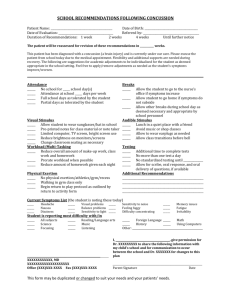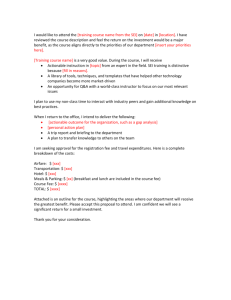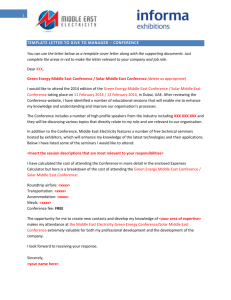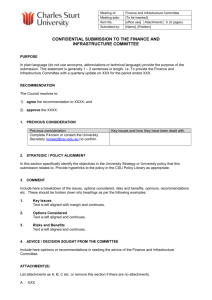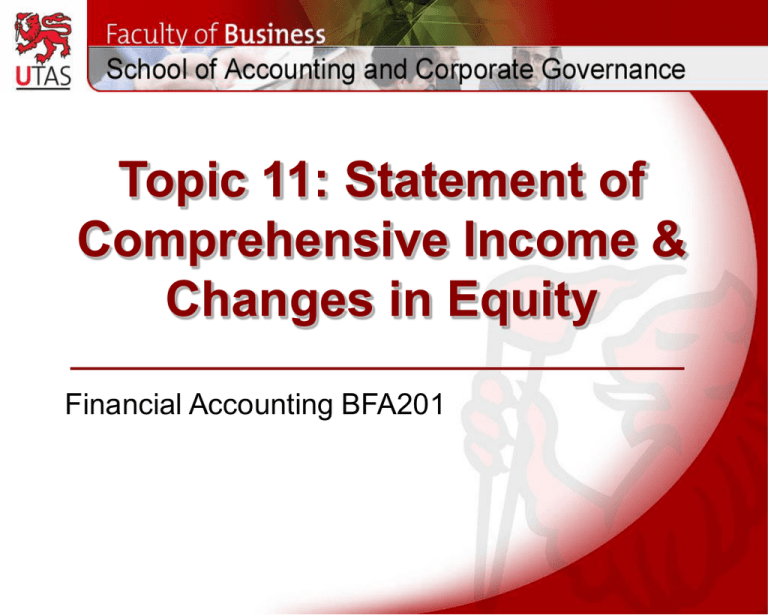
Topic 11: Statement of
Comprehensive Income &
Changes in Equity
Financial Accounting BFA201
Readings and references
• Deegan Chapter 16
• AASB 101 Presentation of Financial Statements
• AASB 108 Accounting Policies, Changes in
Accounting Estimates and Errors
2
Learning Objectives
To understand:
•
how profit or loss & total comprehensive income are
calculated and disclosed in the financial statements of
a reporting entity
•
how to apply AASB 101 to the Statement of
Comprehensive Income & the Statement of Changes in
Equity
•
how to apply AASB 108 - account for and disclose prior
period errors and changes in accounting policy and
changes in accounting estimates
3
Statement of
Comprehensive Income
4
Statement of Comprehensive
Income
•
The statement of comprehensive income provides
information regarding the financial performance of
the entity for the reporting period
•
Income, expenses and other comprehensive income
(e.g. movement in the revaluation surplus) are
summarised in the statement of comprehensive
income.
Measurement of profit
INCOME
Revenue
Expenses
Gains
Profit
& Loss
Income
Statement
6
Measurement of profit
•
Income
•
Expense
•
AASB Framework recognition criteria
•
Determination of income and expenses may depend
on the measurement model adopted
•
Professional judgement and disclosure of
assumptions made in the exercise of professional
judgement
7
Measurement of profit
• Recognising income and expenses
Income and
expenses
Profit and
Loss
Examples:
•Revaluations
•Prior period
errors
Equity
8
Measurement of profit
•
Certain gains and certain expenses will not be taken
into consideration in calculating a reporting entity’s
‘profit or loss’.
•
There are a number of accounting standards that
specifically stipulate that certain expenses (such as
those relating to the correction of prior period
accounting errors) and certain gains (such as those
relating to asset revaluations) are not to be included in
the ‘profit or loss’ of the reporting period.
•
So ‘profit or loss’ of an entity does not include all
expenses and income recognised within the financial
period.
9
Measurement of profit
• A more comprehensive measure of financial
performance is provided by a measure known as
‘total comprehensive income’ – it will include various
gains and expenses that are not incorporated within
‘profit or loss’.
• ‘Total comprehensive income’—which is a relatively
recently developed concept—includes both ‘profit or
loss’ and ‘other items of comprehensive income’.
• Within a financial report, profit or loss is disclosed in
the statement of comprehensive income (which
replaces the ‘income statement’).
10
Measurement of profit
• The format for the statement of comprehensive income is
prescribed in AASB 101 Presentation of Financial
Statements
• AASB 101 requires entities to recognise all items of
income and expense in a period in profit or loss unless a
particular accounting standard requires or permits
otherwise.
• Some expenses and revenues are adjusted directly
against equity e.g. prior period errors (AASB 108)
11
Measurement of profit
Revenue
Expenses
Gains
Profit
and
Loss
OR
Total
Comprehensive
Income
Other
comprehensive
Income
12
Measurement of profit
• Total comprehensive income has two components:
Profit or loss and Other comprehensive income
• The traditional profit measurement is no longer
appropriate due to:
• Changes in the categorisation and labelling of
financial statement elements;
• Reduced emphasis on matching.
13
Measurement of profit
• Specific accounting standards require or permit
components of ‘other comprehensive income’ that meet
the AASB Framework’s definition of income or expense
to be excluded from the calculation of ‘profit or loss’.
•
• Nevertheless, they would be reflected in a measure of
financial performance now referred to as ‘total
comprehensive income’.
• As the name would suggest, ‘total comprehensive
income’ is comprised of ‘profit or loss’ plus other gains
and losses that are recorded directly in various equity
accounts, and is presented in a ‘statement of
comprehensive income’.
14
Measurement of profit
Comprehensive income approach:
• Profit includes all income and expenses as defined in
the Framework.
• It includes all changes in net assets (equity), other than
transactions with owners.
• The contents of the income statement are determined
conceptually, rather than arbitrarily.
• No income or expense items bypass the income
statement.
• The assessment of current performance and prediction
of future performance may be more difficult.
15
Statement of Comprehensive
Income
Income and expense items must be presented as:
one Statement of Comprehensive Income OR two
statements
Income statement
Revenues
Expenses
Other gains & losses
= Income before tax
Income tax expense
Net Income
+
Statement of Comprehensive
Income
Net Income
Foreign currency translation adj.
Unrealised holding gains/losses
Changes in the revaluation
surplus
Other non-owner changes in
equity
Less tax related to OCI
= Comprehensive Income
Statement of Comprehensive Income
• Reporting entities have a choice when presenting
information about their financial performance.
• They can either present a statement of comprehensive
income which provides information about the entity’s
profit or loss plus ‘other items of comprehensive
income’, or they can separately provide both an income
statement and a statement of comprehensive income.
• AASB 101 para 7 defines ‘other comprehensive income’
as follows:
Other comprehensive income comprises items of income
and expense (including reclassification adjustments) that
are not recognised in profit or loss as required or
permitted by other Australian Accounting Standards.
17
Statement of Comprehensive Income:
AASB 101
• Para 82: As a minimum, the statement of comprehensive
income must include amounts for:
• Revenue
• Finance costs
• Share of profits of associates and joint ventures
• Tax expense
• Profit or loss on discontinued operations
• Each component of other comprehensive income
classified by nature
• Income tax related to OCI (para 90)
18
Statement of
Comprehensive
Income –
Presented as a
single statement
19
Statement of Comprehensive Income:
AASB 101
• If we were to look only at profit or loss recorded in the
statement of comprehensive income (or in a separate
income statement) we would not get a full picture of all
the expenses and income (as defined in the AASB
Framework) that were recognised in the current period.
• A joint consideration of the period’s profit or loss, plus a
consideration of items impacting ‘other comprehensive
income’ allows us to more fully appreciate all the income
and expenses of a financial period.
20
Presentation AASB 101
Material
Income
Revenue
(from ordinary
activities)
Gains
Disclose nature &
amount separately
Expenses
Nature
Depreciation
Raw materials
Employee benefits
Function
Cost of Sales
Cost of distribution
Cost of admin.
21
Presentation AASB 101
• Paragraph 97 where items of income or expense are material,
an entity shall disclose their nature and amount separately
• Paragraph 99 – Expense analysis: Entities may choose a
presentation format based on either: their nature or function
• Entities must select the most relevant and reliable format
– Classification by nature might involve expense categories
such as: Depreciation; Purchases of raw materials; and
Employee benefits
– Classification by function might involve expense
categories such as: Cost of sales; Cost of distribution; and
Cost of administration
• Items are NOT to be presented as Extraordinary items
22
Statement of Comprehensive Income
1st form of analysis: nature of expense (para. 102)
Revenue
Other income
Changes in inventories of finished goods
and work in progress
Raw material and consumables used
Employee benefits expense
Depreciation and amortisation expense
Impairment of property, plant and equipment
Other expenses
Finance costs
Share of profit of associates
Profit before tax
Income tax expense
Profit for the year
Other comprehensive income
Gains on property revaluation
Total comprehensive income for the year
2015
xxxx
xxxx
2014
xxxx
xxxx
(xxxx)
(xxxx)
(xxxx)
(xxxx)
(xxxx)
(xxxx)
(xxxx)
xxxx
xxxx
(xxxx)
xxxx
(xxxx)
(xxxx)
(xxxx)
(xxxx)
(xxxx)
(xxxx)
(xxxx)
xxxx
xxxx
(xxxx)
xxxxx
xxxx
xxxx
xxxx
xxxx
2nd form of analysis: Function of expense/ ‘COS’ Method
Para 103
2015
Revenue
xxx
Cost of sales
(xxx)
Gross profit
xxx
Other income
xxx
Distribution costs
(xxx)
Administrative expenses
(xxx)
Finance costs
(xxx)
Profit before tax
xxx
Income tax expense
(xxx)
Profit for the year from continuing operations xxx
Loss for the year from discontinued operations
(xxx)
Profit for the year
xxx
Other comprehensive income
Exchange differences on translating foreign operations
xxx
Available-for-sale financial assets
(xxx)
Cash flow hedges
xxx
Gains on property revaluation
xxx
Income tax relating to components of other comprehensive income xxx
Other comprehensive income for the year, net of tax
(xxx)
Total comprehensive income for the year
xxx
2014
xxx
(xxx)
xxx
xxx
(xxx)
(xxx)
(xxx)
xxx
(xxx)
xxx
(xxx)
xxx
xxx
xxx
xxx
xxx
(xxx)
xxx
xxx
24
Presentation AASB 101
• Recognition of expenses: conventional practice has been to
recognise expenses when the probability is less than 0.5, e.g.
doubtful debts expense.
• Estimation is sometimes necessary when measuring expenses,
e.g. depreciation.
• Measurement of expenses –
– Where expenses are paid by cash, the amount of the
expense is the amount of cash paid.
– Where expenses are an outflow of resources other than
cash, the amount of the expense is the book value of the
outflow.
25
Tax on OCI
• Income tax related to each component of ‘Other
Comprehensive Income’ (OCI) must be shown as
either:
–
Gross
amount
(before tax
effects)
Net:
OR
List aggregate amount
of tax relating to OCI on
Comprehensive Income
Statement
(after tax
effects)
NOTES
to financial
statements
26
Tax on OCI
• ‘Other comprehensive income’ is added to ‘profit for the year’ to
give ‘total comprehensive income for the year’.
• AASB 101 requires entities to disclose the amount of income tax
relating to each component of ‘other comprehensive income’,
either in the statement of comprehensive income, or in the
notes to the financial statements.
• Entities are permitted to present the components of ‘other
comprehensive income’ either before tax effects (gross
presentation) or after their related tax effects (net presentation).
• This is confirmed by AASB 101, paragraph 91, which states:
An entity may present components of other comprehensive income either:
(a) net of related tax effects; or
(b) before related tax effects with one amount shown for the aggregate
amount of income tax relating to those components.
27
Lecture Case Study – part 1
Refer to handout
Complete the Statement of
Comprehensive Income for Wattle
Ltd using function of expense
method.
28
WATTLE LTD
Statement of Comprehensive Income
for the year ended 30 June 2011
NOTE
Sales revenue
Cost of goods sold
Gross Profit
Other income
1
2
Selling expenses
Administrative expenses
Other expenses
Borrowing costs
Profit before income tax
Income tax expense
Profit for the year
4
5
6
7
Other Comprehensive Income
Gain on property revaluation
Tax relating to other comprehensive income
Other Comprehensive Income for the year
Total Comprehensive Income for the year
2011
1,510,000
(948,800)
561,200
274,000
835,200
(275,500)
(205,000)
(94,500)
(1,200)
259,000
(77,700)
$181,300
3
8
45,000
(13,500)
31,500
$
212,800
2010
x
x
x
x
x
x
x
x
Note 1: Sales Revenue:
Sales - $1535000 less sales returns $25,000
Note 2: COGS:
COGS - $942,800 plus freight inward $6,000
Note 3: Other income:
Services revenue
Proceeds on sale of machinery
Carrying amount of machiney sold
54,000
-50,000
Note 4: Selling Expenses
Freight outwards
Advertising expense
Sales staff salaries
Sales staff vehicle expenses
Telephone expense
Depreciation of sales staff motor vehicles
Total Selling Expenses
7,000
10,000
200,000
16,000
12,500
30,000
275,500
270,000
4,000
274,000
30
Note 5: Administrative expenses
Administrative staff salaries expense
Depreciation - office furniture
Total Administrative Expenses
Note 6: Other Expenses
Rent expense
Rates expense
Insurance expense
Depreciation of machinery
Depreciation - buildings
Total Other Expenses
Note 7: Borrowing costs - Interest
expense
Note 8: Revaluation of property
Building at cost
Less accumulated depreciation
Carrying amount
Fair Value as at 30/6/11
Revaluation increment
193,000
12,000
205,000
16,500
15,000
20,000
18,000
25,000
94,500
1,200
500000
-125000
375000
420000
45000
Changes in accounting estimates AASB 108
• Para. 32 – estimates used e.g. bad debts, fair value of
financial assets, useful lives of depreciable assets,
warranty obligations (does not undermine reliability
para. 33)
• Para. 5 – changes in estimates arises from new
information or new developments so are not correction
of errors (and not change in accounting policy para. 35)
32
Changes in accounting estimates –
recording
• Para. 34 recognised prospectively by including in profit
or loss in:
– Period of the change, if the change affects that period
only (eg prov for bad debts); or
– The period of the change & future periods (eg change
in useful life of depreciable asset)
• If also affects assets and liabilities then need to adjust
carrying amount in the period of the change (para. 37)
33
Lecture Example 1
30 June 2013, Topsy Ltd on further information
decided to revise the useful life of machinery
(purchased for $400,000 on 1 July 2010, depreciated
on straight-line basis with no residual) from 8 years to 5
years. No depreciation recorded for current period.
• Prepare journal entry to account for change in
accounting estimate
• Prepare appropriate supporting note as change had
a material effect.
34
Solution
Dr
Cr
Depreciation
100,000
Acc Deprec – machinery
100,000
Supporting note – change in accounting estimate:
Profit before tax has been arrived at after
taking into account:
Depreciation
Original
Change in accounting estimate
2013 ($)
2012 ($)
50,000
50,000
100,000
50,000
–
50,000
As a result of the revision during the year of the est. life of
the machinery from eight to five years, the depreciation
charge will increase by $50,000 for the following three
years.
35
Statement of Changes
in Equity
36
Statement of Changes in Equity
•
•
•
•
•
Reconciles opening and closing equity
Provides details of each equity account:
» Share capital
» Retained profit
» Revaluation surplus
Lists how each component is impacted by total
comprehensive income
– Eg. AASB108 errors or revaluation
Lists transactions with owners
Comparative information required
37
Statement of Changes in Equity
•
AASB 101 para. 106 requires the preparation of a
Statement of Changes in Equity
•
A statement of changes in equity shows:
a) Total comprehensive income for the period
b) For each equity component, effects of changes in
accounting policies and correction of errors
d) For each component of equity, a reconciliation
between beginning & end of period; separately
disclosing changes from:
i. profit or loss;
ii. other comprehensive income &
iii. transactions with owners (contributions;
distributions & ownership changes)
Lecture Example 2: Statement of
Changes in Equity preparation
The shareholders’ equity section of the balance sheet of Newton
Ltd at 30 June 2010 was as follows:
Share capital
General reserve
Revaluation surplus
Retained earnings
2010
200,000
50,000
74,000
170,000
2009
160,000
40,000
60,000
160,000
494,000
420,000
Additional information
• Newton Ltd issued 16 000 shares at $2.50 each on 31 May 2010 for cash.
• A transfer of $10 000 was made from retained earnings to the general reserve
• Net profit for the year was $130 000
• Dividends for the year comprised: interim dividend $50 000; final dividend
provided $60 000.
• Land was revalued to current fair value, resulting in the recognition of a gross
revaluation increment of $20 000 and a deferred tax liability of $6 000.
39
Solution
Newton Ltd
Statement of Changes in Equity
for the year ended 30 June 2010
Balance at 1 July 2009
Share General Revaluation Retained
capital reserve
surplus
earnings
Total
equity
160,000
40,000
60,000
160,000
420,000
14,000
130,000
144,000
Changes in Equity for 2010
Total comprehensive income for the year
(net of tax)
Distributions to shareholders
(110,000) (110,000)
Transfer to general reserve
Issue of share capital
Balance at 30 June 2010
10,000
(10,000)
40,000
200,000
0
40,000
50,000
74,000
170,000
494,000
40
Lecture Case Study – part 2
Refer to handout
Complete the Statement of Changes in
Equity for Wattle Ltd.
41
Lecture Case Study - solution
WATTLE LTD
Statement of Changes in Equity
for the year ended 30 June 2011
Share
capital
Balance at 1 July 2010
887,000
General Revaluation Retained
reserve
Surplus earnings Total equity
5,000
80,000 140,000
1,112,000
31,500 181,300
212,800
Dividend declared - ordinary
(80,000)
(80,000)
Dividend declared - preference
(40,000)
(40,000)
10,000
(10,000)
0
15,000
111,500 191,300
1,204,800
Changes in Equity for 2011
Total comprehensive income for
the year
Transfer to general reserve
Balance at 30 June 2011
887,000
42
Prior period errors AASB 108
• Para. 5 prior period errors: omissions or
misstatements in financial statements for prior
periods arising from misuse of reliable information
available at the time and could have been
obtained and used (eg math mistakes, mistakes
in applying policies, oversights, fraud).
43
Prior period errors - recording
• Correction is excluded from profit or loss of the
period in which it is discovered.
• Adjust opening balance of retained earnings and
restate comparative information.
• Change in accounting estimates are not
corrections of errors.
44
Lecture Example 3
During 2013 Mayhem Ltd discovered that payment
to a supplier of $4,000 had been omitted in the
2012 financial statements. Tax rate is 30%. The
following information has been supplied before
incorporation of the error. Correct this in
accordance with the requirements of AASB 108.
45
Mayhem Limited
Abridged Statement of Comprehensive Income
for the year ended 30 June 2013
2013
2012
Profit before tax
28,500
35,400
Income tax exp
8,550
10,620
Profit for the year
19,950
24,780
46
Mayhem Limited
Statement of Changes in Equity
for the year ended 30 June 2013
Share
capital
Balance at 30 June 2011 6,000
Retained
earnings
9,000
Total
15,000
Profit for the year ending
–
30 June 2012
Distributions
–
Balance at 30 June 2012 6,000
24,780
24,780
(3,000)
30,780
(3,000)
36,780
Profit for the year ending
–
30 June 2013
Distributions
–
Balance at 30 June 2013 6,000
19,950
19,950
(3,000)
16,950
(3,000)
22,950
47
Solution
Mayhem Limited
Abridged Statement of Comprehensive Income
for the year ended 30 June 2013
2013
2012
Profit before tax
28,500
31,400
Income tax exp
8,550
9,420
Profit for the year
19,950
21,980
48
Solution
Mayhem Limited
Statement of changes in equity
for the year ended 30 June 2013
Share
capital
Retained
earnings
Total
Balance at 30 June 2011 6,000
9,000
15,000
Profit for the year as
–
restated
Distributions
–
Balance at 30 June 2012 6,000
21,980
21,980
(3,000)
27,980
(3,000)
33,980
Profit for the year ending
–
30 June 2013
Distributions
–
Balance at 30 June 2013 6,000
19,950
19,950
(3,000)
16,950
(3,000)
22,950
BFA201_13
49
Solution cont.
Notes to the financial statements
Note 2 Prior period error
An amount due to a supplier was omitted during
preparation of 2012 financial statements. The 2013
figures have been restated to take into account the
omission. The effect of the restatement on those financial
statements is summarised below. There is no effect on
2013 results.
50
Solution cont.
Increase in expenses
Decrease in income tax expense
Decrease in profit
Increase in accounts payable
Decrease in tax payable
Decrease in equity
Effect on 2012
(4,000)
1,200
(2,800)
(4,000)
1,200
(2,800)
51
Example: Statement of Changes in Equity
(with changes in accounting policy)
Balance at 1/01/2011
Changes in
accounting policy
Restated balance
Changes in equity
for 2011
Dividends
Total comprehensive
Income for the year
Balance at
31 December 2011
Changes in equity
for 2012
Issue of share capital
Dividends
Total comprehensive
income for the year
Transfer to retained
earnings
Balance at
31 December 2012
Share
Capital
($000)
xxx
Retained
earnings
($000)
xxx
Cash
flow
hedges
($000)
xxx
Revaluation
surplus
($000)
–
Total
($000)
xxx
–
xxx
xxx
xxx
–
xxx
–
–
xxx
xxx
–
(xxx)
–
–
(xxx)
–
xxx
(xxx)
xxx
xxx
xxx
xxx
(xxx)
xxx
xxx
xxx
–
–
(xxx)
–
–
–
–
xxx
(xxx)
–
xxx
(xxx)
xxx
xxx
–
xxx
–
(xxx)
–
xxx
xxx
(xxx)
xxx
xxx
52
Next Week – Week 12 Other disclosure
issues
Copyright notice
© Copyright University of Tasmania, School of Accounting & Corporate
Governance
All rights reserved.
Commonwealth of Australia Copyright Regulations 1969 - WARNING
This material has been reproduced and communicated to you by or on behalf of the University
of Tasmania pursuant to Part VB of the Copyright Act 1968 (the Act). The material in this
communication may be subject to copyright under the Act. Any further reproduction or
communication of this material by you may be the subject of copyright protection under the Act.
Do not remove this notice.
53

